An identification for other objects belonging to an OPC Driver can be inserted manually, or else automatically retrieved from an OPC Server. To do so, open a Driver's Properties Window, by right-clicking it and then selecting the OPC Driver tab.
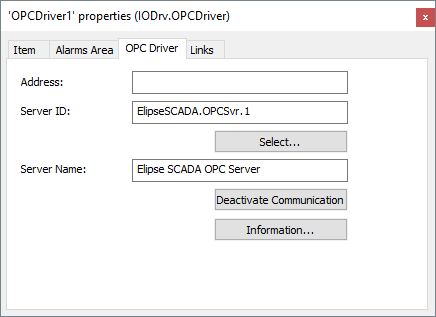
OPC Driver tab
Type an Address and a Server ID and then click Select. The window on the next figure is then displayed.
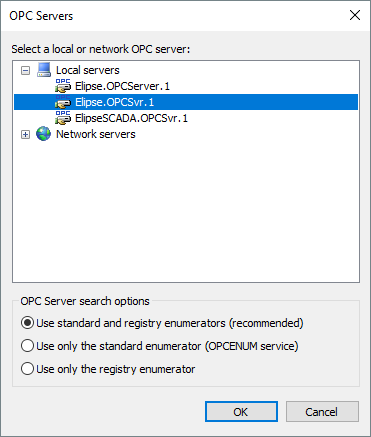
Selecting an OPC Server
The available options on the OPC Server search options item are described on the next table.
Available options for OPC Server search options item
Option |
Description |
|---|---|
Use standard and registry enumerators (recommended) |
E3 tries to search for Driver specifications, either via Windows Registry or via standard OPC enumerator (OPCENUM) |
Use only the standard enumerator (OPCENUM service) |
E3 tries to search for Driver specifications only via standard OPC enumerator (OPCENUM) |
Use only the registry enumerator |
E3 tries to search for Driver specifications only via Windows Registry |
By clicking OK, E3 Studio displays Driver's data, indicating paths and server's name. To activate OPC Driver communication, click Activate Communication.
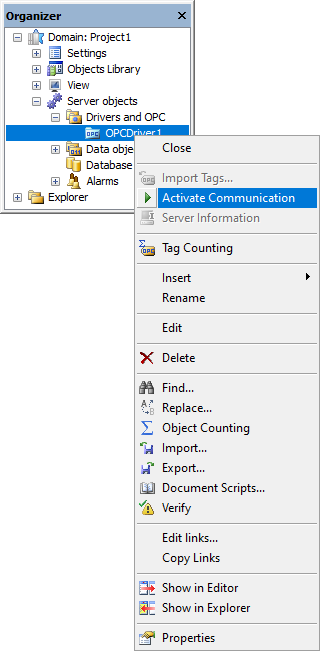
Activating OPC Driver communication
When communication is activated, the Server Information and Import Tags options are enabled, and also the Deactivate Communication option. To use these options, right-click an OPC Driver and select the preferred option.

Enabled options when an OPC Driver is active
The Server Information option shows a window with Driver configurations.
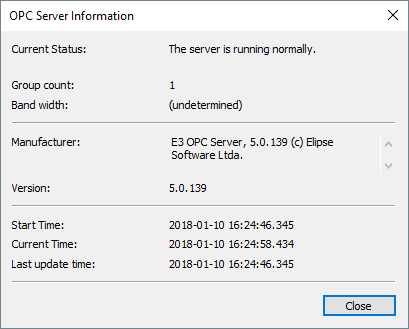
OPC Server information
By using the Import Tags option, users can import Tags to an OPC Driver. When this option is selected, the dialog box on the next figure is displayed.
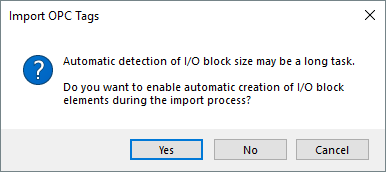
Message referring to OPC Tag import
The available options on this dialog box are the following:
•Yes: When locating OPC Tags, E3 automatically tries to detect which Tags are Block Tags and, in this case, how many Elements they have. To do so, E3 needs to read each Element's value, and depending on the server and on the number of Tags, this can be a time-consuming task
•No: E3 does not try to read OPC Tag values when performing this search. This operation is quicker, but it does not create Block-type OPC Tags and their Elements automatically
•Cancel: Cancels this import operation
The Import OPC Tags window provides all resources displayed on the next figure.

Importing OPC Tags
The available options on this window are described on the next table.
Available options for Import OPC Tags window
Option |
Description |
|---|---|
Item names |
Filters Tags using the name of these specified items. Users can use wild cards, such as * (asterisk) or ? (question mark) |
Data type |
Filters Tags using a data type specified in this field, which can be Integer, Long, Single, etc. |
Access type |
Filters Tags using an access type specified in this field, which can be Read only, Write only, and Read and Write |
Show only items with IDs not found in the current project |
Filters Tags so that this application only shows items with IDs not found in a project |
Current project |
Shows selected objects to add to the current project |
OPC Server |
Shows available Tags in a server for import |
To import Tags, select a Tag and drag it to an OPC Driver or OPC Group. To deactivate OPC Driver communication, click Deactivate Communication.
Some OPC Driver properties can be configured using Properties List, without creating scripts for this. To configure any property, locate it on Properties List and perform the necessary adjustments. For more information, please check the E3 Reference and Scripts Manual.